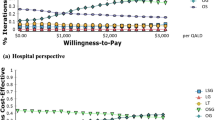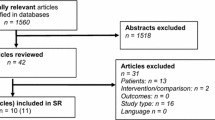Abstract
Background
Despite 100,000 ventral hernia repairs (VHR) being performed annually, no gold standard for the technique exists. Mesh has been shown to decrease recurrence rates, yet, concerns of increased complications and costs prevent its systematic use. We examined the cost-effectiveness of open suture (OS) versus open mesh (OM) in primary VHR.
Methods
A decision analysis model from the payer’s perspective comparing OS to OM was constructed for calculating the total costs and cost-effectiveness. Probabilities for complications and outcomes were derived from the literature. The costs represented institutional fixed costs. The outcome measure of effectiveness was recurrence. One-way sensitivity analysis and a probabilistic analysis using Monte Carlo simulation were performed.
Results
OS was associated with a total cost of $16,355 (±6,041) per repair, while OM was $16,947 (±7,252). At 3-year follow-up, OM was the more effective treatment with 73.8% being recurrence-free, compared with 56.3% in the OS group. The incremental cost to prevent one recurrence by the placement of mesh was $1,878. OM became the less effective treatment strategy when the infection rate exceeded 35%. At a willingness to pay level of $5,500, OM was the more cost-effective treatment strategy.
Conclusion
In subjects without contraindication to mesh placement, OM repair is the more effective surgical treatment for VHR, with a lower risk of recurrence at a small cost to the payer.



Similar content being viewed by others
References
Heniford BT, Park A, Ramshaw BJ, Voeller G (2003) Laparoscopic repair of ventral hernias: nine years’ experience with 850 consecutive hernias. Ann Surg 238(3):391–399; discussion 399–400
Carbajo MA, Martp del Olmo JC, Blanco JI, Toledano M, de la Cuesta C, Ferreras C, Vaquero C (2003) Laparoscopic approach to incisional hernia. Surg Endosc 17(1):118–122
Raftopoulos I, Vanuno D, Khorsand J, Kouraklis G, Lasky P (2003) Comparison of open and laparoscopic prosthetic repair of large ventral hernias. JSLS 7(3):227–232
Ramshaw BJ, Esartia P, Schwab J, Mason EM, Wilson RA, Duncan TD, Miller J, Lucas GW, Promes J (1999) Comparison of laparoscopic and open ventral herniorrhaphy. Am Surg 65(9):827–831; discussion 831–2
Anthony T, Bergen PC, Kim LT, Henderson M, Fahey T, Rege RV, Turnage RH (2000) Factors affecting recurrence following incisional herniorrhaphy. World J Surg 24(1):95–100; discussion 101
Hesselink VJ, Luijendijk RW, de Wilt JH, Heide R, Jeekel J (1993) An evaluation of risk factors in incisional hernia recurrence. Surg Gynecol Obstet 176(3):228–234
Flum DR, Horvath K, Koepsell T (2003) Have outcomes of incisional hernia repair improved with time? A population-based analysis. Ann Surg 237(1):129–135
Korenkov M, Paul A, Sauerland S, Neugebauer E, Arndt M, Chevrel JP, Corcione F, Fingerhut A, Flament JB, Kux M, Matzinger A, Myrvold HE, Rath AM, Simmermacher RK (2001) Classification and surgical treatment of incisional hernia. Results of an experts’ meeting. Langenbecks Arch Surg 386(1):65–73
Luijendijk RW, Hop WC, van den Tol MP, de Lange DC, Braaksma MM, IJzermans JN, Boelhouwer RU, de Vries BC, Salu MK, Wereldsma JC, Bruijninckx CM, Jeekel J (2000) A comparison of suture repair with mesh repair for incisional hernia. N Engl J Med 343(6):392–398
Burger JW, Luijendijk RW, Hop WC, Halm JA, Verdaasdonk EG, Jeekel J (2004) Long-term follow-up of a randomized controlled trial of suture versus mesh repair of incisional hernia. Ann Surg 240(4):578–583; discussion 583–5
Hunink M, Glasziou P, Siegel J, Weeks J, Pliskin J, Elstein A, Weinstein M (2001) Decision making in health and medicine: integrating evidence and values. Cambridge University Press, New York, pp 1–380
Finan KR, Vick CC, Kiefe CI, Neumayer L, Hawn MT (2005) Predictors of wound infection in ventral hernia repair. Am J Surg 190(5):676–681
Dunne JR, Malone DL, Tracy JK, Napolitano LM (2003) Abdominal wall hernias: risk factors for infection and resource utilization. J Surg Res 111(1):78–84
Basoglu M, Yildirgan MI, Yilmaz I, Balik A, Celebi F, Atamanalp SS, Polat KY, Oren D (2004) Late complications of incisional hernias following prosthetic mesh repair. Acta Chir Belg 104(4):425–428
Medina M, Sillero M, Martínez-Gallego G, Delgado-Rodríguez M (1997) Risk factors of surgical wound infection in patients undergoing herniorrhaphy. Eur J Surg 163(3):191–198
Cobb WS, Harris JB, Lokey JS, McGill ES, Klove KL (2003) Incisional herniorrhaphy with intraperitoneal composite mesh: a report of 95 cases. Am Surg 69(9):784–787
Vrijland WW, Jeekel J, Steyerberg EW, Den Hoed PT, Bonjer HJ (2000) Intraperitoneal polypropylene mesh repair of incisional hernia is not associated with enterocutaneous fistula. Br J Surg 87(3):348–352
Bauer JJ, Harris MT, Kreel I, Gelernt IM (1999) Twelve-year experience with expanded polytetrafluoroethylene in the repair of abdominal wall defects. Mt Sinai J Med 66(1):20–25
National Vital Statistics Report (2002) Centers for Disease Control and Prevention. 16 Sept 2002;50(15)
Dimick JB, Chen SL, Taheri PA, Henderson WG, Khuri SF, Campbell DA Jr (2004) Hospital costs associated with surgical complications: a report from the private-sector National Surgical Quality Improvement Program. J Am Coll Surg 199(4):531–537
Gold RS (1996) Cost-effectiveness analysis as a guide to resource allocation in health: roles and limitations. In: Weinstein MC, Gold MR (eds) Cost-effectiveness in health and medicine. Oxford University Press, New York, pp 3–25
Korenkov M, Sauerland S, Arndt M, Bograd L, Neugebauer EA, Troidl H (2002) Randomized clinical trial of suture repair, polypropylene mesh or autodermal hernioplasty for incisional hernia. Br J Surg 89(1):50–56
Israelsson LA, Jönsson L, Wimo A (2003) Cost analysis of incisional hernia repair by suture or mesh. Hernia 7:114–117
White TJ, Santos MC, Thompson JS (1998) Factors affecting wound complications in repair of ventral hernias. Am Surg 64(3):276–280
Gray SH, Vick CC, Graham LA, Finan KR, Neumayer LA, Hawn MT (2008) Variation in mesh placement for ventral hernia repair: an opportunity for process improvement? Am J Surg 196:201–206
Navarra G, Musolino C, De Marco ML, Bartolotta M, Barbera A, Centorrino T (2007) Retromuscular sutured incisional hernia repair: a randomized controlled trial to compare open and laparoscopic approach. Surg Laparosc Endosc Percutan Tech 17(2):86–90
Barbaros U, Asoglu O, Seven R, Erbil Y, Dinccag A, Deveci U, Ozarmagan S, Mercan S (2007) The comparison of laparoscopic and open ventral hernia repairs: a prospective randomized study. Hernia 11(1):51–56
Misra MC, Bansal VK, Kulkarni MP, Pawar DK (2006) Comparison of laparoscopic and open repair of incisional and primary ventral hernia: results of a prospective randomized study. Surg Endosc 20(12):1839–1845
Acknowledgments
We would like to thank Dr. Miguel Arguedas for his assistance in the decision modeling and Ms. Catherine Vick for her assistance in providing probabilities from the Veterans Affairs Medical Center ventral hernia repair study. K.R. Finan is a research fellow for the Department of Surgery supported by an educational grant funded by Olympus America Inc. This research was presented at the 2005 American College of Surgeons Clinical Congress, Surgical Forum in San Francisco, California, October 2005, and was awarded the Surgeons’ Forum on Fundamental Surgical Problems Resident/Fellow Excellence in Research Award.
Author information
Authors and Affiliations
Corresponding author
Rights and permissions
About this article
Cite this article
Finan, K.R., Kilgore, M.L. & Hawn, M.T. Open suture versus mesh repair of primary incisional hernias: a cost–utility analysis. Hernia 13, 173–182 (2009). https://doi.org/10.1007/s10029-008-0462-1
Received:
Accepted:
Published:
Issue Date:
DOI: https://doi.org/10.1007/s10029-008-0462-1




